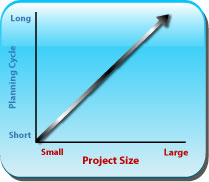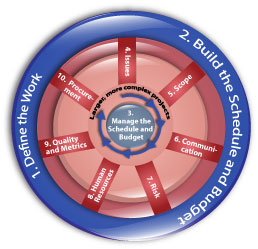 |
 |
![]()
1.0 Define the Work
(1.0.P1)
How many times have you heard about or been involved in a project that failed miserably? Or perhaps it just was not as successful as it needed to be. Did you ever spend time looking back to see what caused the project to go wrong? If you did, chances are that you will have said, "You know, we should have spent more time planning."
Most projects have deadlines, and it seems they are getting shorter and shorter. Hitting aggressive deadlines puts pressure on the project manager to start the project as soon as possible. However, before the project work begins, you need to spend time in up-front planning to make sure that the work is properly understood and agreed to. This is not wasted time or 'overhead' time. This is the time the project manager spends ensuring that the project team and the sponsor have common perceptions of what the project is going to deliver, when it will be complete, what it will cost, who will do the work and how the work will be done.

High-level process flow
At the end of a difficult project, the benefits of planning might be obvious. But the benefits are known ahead of time as well. At a high-level, these benefits include:
-
Understanding and gaining agreement on project objectives, deliverables, scope, risk, cost, approach, etc. This ensures that the project team and sponsor agree on the work that is required.
-
Determining if the original business case is still valid. When the project was initially approved, the project cost and duration were probably estimated at a high-level – maybe up to ± 50%. Now that the project is starting, the estimates should be revalidated to get them closer to ± 15%. This additional refinement may result in the estimates ending up higher than before, and these higher numbers may make the business case unattractive. For instance, a project that requires 10,000 effort hours might make business sense. If the more detailed planning process results in a more refined estimate of 20,000 hours, the project may not make business sense anymore.
-
Making sure the resources you need are available when you need them. This is a result of creating the project schedule with resources assigned.
-
Providing a high-level baseline from which progress can be compared. This is a result of creating the milestone timeline based on the more detailed schedule.
-
Validating the processes used to manage the project ahead of time with the sponsor. The procedures that are used to manage the project should not be a surprise. They should be discussed and agreed to ahead of time.
 It should make sense that small projects
need a shorter planning cycle and larger projects need a longer planning
cycle. The effort required to define the work depends on the amount of
information and the level of detail that need to be understood and
documented. The duration required to define the work depends on the
length of time necessary to discover and document the information, as
well as the time required to gain agreement and approval from the
sponsor.
It should make sense that small projects
need a shorter planning cycle and larger projects need a longer planning
cycle. The effort required to define the work depends on the amount of
information and the level of detail that need to be understood and
documented. The duration required to define the work depends on the
length of time necessary to discover and document the information, as
well as the time required to gain agreement and approval from the
sponsor.
At times, the project manager can get frustrated because of the difficulty in gaining agreement with the sponsor on scope, schedule and cost. But that is exactly the reason this work is done ahead of time. Think of the problems you will encounter trying to gain agreement with the sponsor on scope, schedule or cost when the work has started and the deliverables are actually being produced.
Understanding Projects (1.0.P2)
Before you learn how to define the work, you should be clear on the definition of a project itself. This will make it clearer as to when formal project management techniques are appropriate. Please review:
The processes used to manage your project need to be scalable based on the size of the project. Large projects need to be managed with more rigor and structure than small projects.
Sizing the Project (Small, Medium, Large) (1.0.P3)
The processes used to manage your project need to be scalable based on the size of the project. Large projects need to be managed with more rigor and structure than small projects.
The TenStep process contains specific guidance for how to manage a project based on the size. But first, you have to categorize your project as large, medium or small. In some companies a project of six months and 10,000 hours would be considered large. In other organizations, this same project would be considered small. The TenStep process includes some guidelines, but each organization should determine the guidelines that make sense for them. See 1.0.3 Sizing your Project (Small, Medium, Large) for more information.
After you have reviewed the prior information, proceed through the information on defining your project.
![]() 1.2
Define the Work / Techniques
1.2
Define the Work / Techniques
![]() 1.3 Define
the Work / Quick Reference
1.3 Define
the Work / Quick Reference
[Previous -
0.0.1 Identify Stakeholders
![]() ]
[Next -
1.0.1 What is
a Project?]
]
[Next -
1.0.1 What is
a Project?]
